|
Introduction
John Neave was
one of the last letterpress printers in the area. He had
been in business since 1949 and celebrated his 74th year
as a printer in 2023. He had many memories of long-gone
printing companies, including suppliers to the trade.
What follows is the story of one of his best suppliers,
Mr. William A. Parkes of Wolverhampton. This is based on
John’s memories of Mr. Parkes’ business, which was just
around the corner from John’s workshop. As a young lad
John would often cycle there to buy type and various
consumables for his business.
Background
Until the latter
part of the 20th century there were many
letterpress printing companies using the traditional
printer’s type. There were both large and small
printers, which produced much of the printed material
that was used locally. Everything was produced from
table place names, business cards, letterheads, forms,
advertising literature, and posters, through to books,
which were printed by the larger companies. We must also
remember that much of the printing ink was produced in
Wolverhampton by Manders. |
|
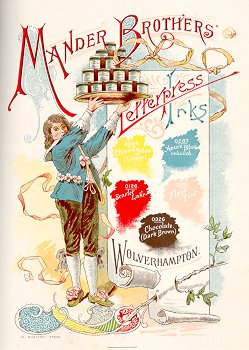
An advert for Mander's printing
inks. |
A look in the
old Red Books reveals a long list of local printers such
as Barford & Newitt, G.E. Lee, W. Gibbons, Alfred Hinde,
J. Mulliner, Paulton Bros., Steens Ltd., Whitehead
Bros., and many, many more. Printing was an important
industry, there were large numbers of local printers,
and like any other industry it required raw materials
and consumables.
A good stock of
type was essential for any printer. But there were times
when an urgent job would require an unusual font, an
extra large font size, or little used symbols, and so
access to a good reliable local type supplier could make
the difference between finishing the order on time, or
being late.
There were
several local suppliers in Wolverhampton and the
surrounding area who cast their own type, such as
Midland Creative Designs at 20 Queen Street,
Wolverhampton and Reliance Type Setting in Walsall, who
cast “Qualitype”. |
|
One of the best
type founders was William A. Parkes, of 56 Sutherland
Place, Wolverhampton. Unlike most of the others, he not
only cast his own type but also stocked an extensive
range of type and all of the local printer’s
consumables, except paper.
Beginnings
56 Sutherland
Place was the Parkes’ family home, opposite where the
back of the Royal Hospital is today, about half-way
along the modern car park. Until the end of the First
World War, William Parkes worked as a book keeper at the
Chillington Tool Company. Around the end of the war in
1918 he had a win on the football pools and decided to
set himself up in business. |
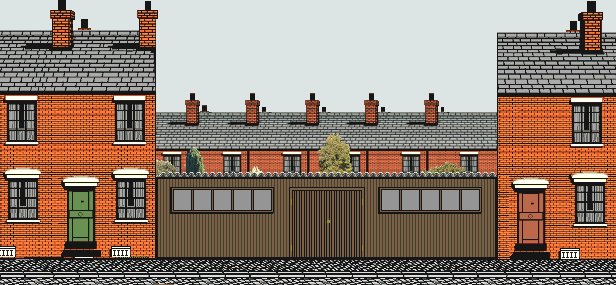
An impression of how Mr. Parkes' building
might have looked when it was first built. The houses in the
background are in Portland Place, which disappeared in the 1930s as
the Royal Hospital expanded.
| He purchased a large single
storey wooden building with a corrugated steel roof, and
it was erected diagonally opposite the family’s house in
Sutherland Place. The
building was between 40 and 50 feet wide, with two large
double doors on the front, and two rows of windows. It
occupied a site that had previously been used as a coal
yard. The interior was divided into two parts by a
partition, which separated the type foundry at the back
from the stock room and sales area at the front.
|

The approximate position of Mr.
Parkes' building. |
|
The front part
contained much of Mr. Parkes’ stock, stored on wooden
shelving. There were two wooden benches about 12ft.
long, one on either side of the room, with Mr. Parkes’
old desk in the centre. He would sit behind the desk on
an old wooden box with a piece of carpet on the top.
Heating was supplied by a coke stove, and when the
temperature fell, Mr. Parkes could often be found
warming himself by the fire. Mr. Parkes' wife Joan
constantly supplied the shop with hot tea and food from
their house across the road.
In the 1940s Mr. Parkes, his sons,
and a couple of cousins played snooker in the West
Midlands League as members of the Working Men's Club
team based in Cleveland Road. They represented the club
for a number of years, and were quite successful. When
opposing teams played them, they would say they were
playing the Parkes's. They won many prizes, and as a
result the women of the family never bought an iron,
because they were often given as prizes in the various
competitions.
The Business
He had three
sons, Archie, Bob, and Jack,
all of whom worked in the business for a time. For many
years the business sold type to Australia, which was
very lucrative. Unfortunately the Australian Government
increased their import duty to such an extent that
orders fell, and the business could no longer support
both sons. As a result one of them had to find work
elsewhere. Archie, the son who stayed at the business,
had many duties including casting type, casting rollers
for printing machines, and looking after the post. |
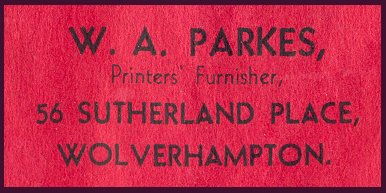 |
They had a large mail-order
business with customers from all over the country.
Each day Archie would go the main
post office in Lichfield Street to put the day’s orders
in the post. Every order would be neatly wrapped in
brown paper and tied up with string. |
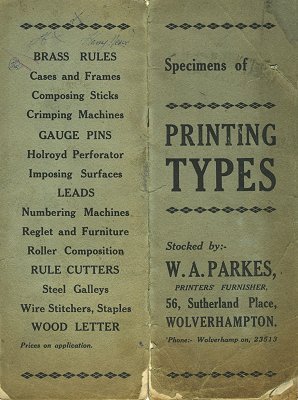 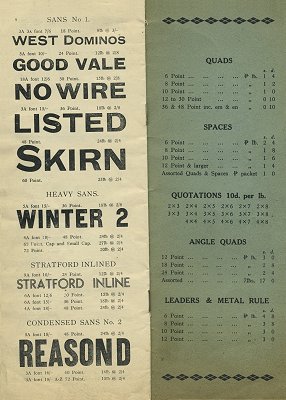 |
|
A
Parkes type catalogue. Courtesy of Stephen
Howard, Black Country Living Museum. |
|
|
Some of Mr.
Parkes' type. |
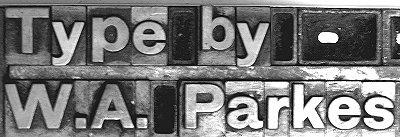 |
| Mr. Parkes was an agent for type
founders Stephenson, Blake & Company, and kept a very
large stock of type from 6pt. to 72pt. in many different
fonts. |
|
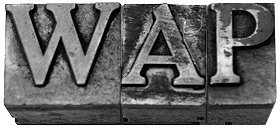
More type from Mr. Parkes.
|
The type was wrapped in brown
paper and stored on the shelves in the front room. Some
of the older stock had been there since the 1920s.
His prices were very competitive
and the type was extremely good value for money, a whole
font only costing between 3 shillings and seven
shillings and sixpence. |

A Parkes' price list. The A
and B
refer to different fonts and C is for symbols. |
| Mr. Parkes was also an agent for
Mander’s inks and sold most of the consumables that were
needed by the local trade, including brass rules, cases
and frames, composing sticks, crimping machines,
galleys, gauge pins, mallets, numbering machines,
perforators, planers, roller composition, rule cutters,
staples, tweezers, and wire stitchers. He was
well-known, and his customers came from all over the
Black Country.
Although Mr. Parkes always had a vast collection of type
in stock, he also produced his own. His type, cast in
the back room, became well known for its hard wearing
properties. He used Davies casting machines, which were
gas heated and hand operated. They cast type in a row of
single letters, which were dressed to remove any rough
edges, and planed on the back.
The casting
machines produced up to 5 letters a minute, and so were
very slow when compared with the high speed monotype
casting machines, which were commonly used at the time.
Mr. Parkes’ alloy however, was far superior to that used
in the monotype machines, due to its hard wearing
properties. He also produced at least one font of his
own, called Borghese, a very old style font, which was
designed by a professor of calligraphy at Nottingham
University. |
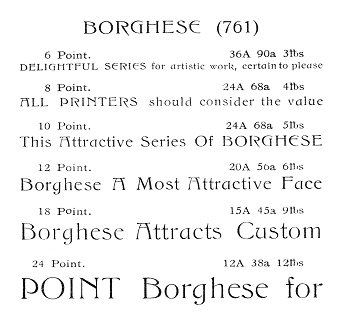
The Borghese Font.
| Mr. Parkes sold Mander’s roller
composition, which could be melted in a glue pot and
cast into replacement rollers for printing machines.
He also produced replacement rollers made from Mander’s
composition, which were very cheap and could be
purchased at almost the same price as the composition
itself, so they were well worth buying.
Archie used to melt the
composition in a glue pot that stood on a stand above a
coke fire. His rollers were popular and Archie could
often be seen casting rollers for some old platen
machine. |
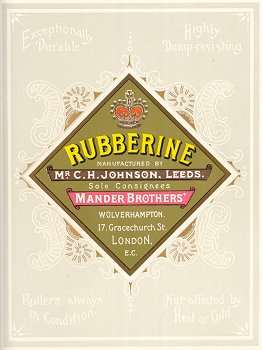
An advert for
Mander’s roller composition. |
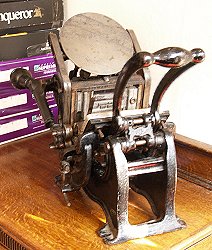
The small type of printing
machine that Mr. Parkes would sell. |
In order to supplement his
income, Mr. Parkes also sold second-hand printing
machines, and a few new machines that were made by
Taylors of Leicester. The
old machines were usually purchased very cheaply from
printers that had gone out of business. He kept a lot of
machines in stock, mainly old Cropper machines or Arab
platens, some of which were treadle operated and had a
flywheel.
The machines could be quite large,
in sizes such as Foolscap Folio (13” x 8”), or Crown
Folio (15” x 10”). Many of the machines dated from
around 1900 and a lot were exported to Africa. |
|
The End
William Parkes
died in the late 1950s when he was well into his 80s. He
never retired, and had worked hard for many years, for
little money, in a demanding, laborious, and highly
skilled job. After William's death Archie ran the
business single-handed. His brother Bob is believed to
have got a job at Chillington Works, where he died of a
heart attack at the age of around 40. Jack moved to Ever
Ready in Lower Walsall Street where he operated a lathe.
He finished his working life at Lucas Aerospace at
Fordhouses and lived into his seventies, dying due to
complications from Emphacemia.
During most of
his time in the business Archie lived in Whitmore Reans
and used to cycle to and from work. Sadly his wife died
young and he eventually moved back to Sutherland Place,
living in a house opposite the premises. The business
started to slow down during the war years, and was later
affected by the emergence of offset litho printing which
soon dominated the industry and took over from
traditional letterpress.
Over the years
the Royal Hospital had greatly expanded, and in the
early 1960s it was decided that a new Accident and
Emergency Department would be built. Land for the new
department, including that occupied by Mr. Parkes, was
acquired in about 1964, two years before the completion
of the project. Archie sold the printing business to
Raymond Jones of Tipton and the building soon
disappeared.
When the
business closed, Archie went to see John Neave to ask if
he could have a job. Sadly John had to refuse because he
was still getting established himself. Luckily Archie
managed to find a job with an engineering firm in
Sharrock Street and worked there for around two years.
I would like to thank Ian Parkes
for his help in producing this section.
If anyone can add to the story, or
has a photograph of Mr. Parkes, or his building, please
contact the
webmaster. |
 |
Return to
the
Printing Hall |
|